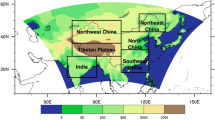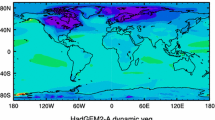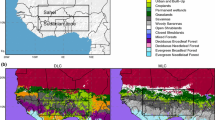Abstract
The influence of different vegetation distributions on the atmospheric circulation during the Last Glacial Maximum (LGM, 21 000 years before present) is investigated. The atmospheric general circulation model of the Bureau of Meteorology Research Center was run using a modern vegetation and in a second experiment with a vegetation reconstruction for the LGM. It is found that a change from conifer to desert and tundra causes an additional LGM cooling of 1–2 °C in Western Europe, up to −4 °C in North America and −6 °C in Siberia. An expansion of dryland vegetation causes an additional annual cooling of 1–2 °C for Australia and northern Africa. On the other hand, an increase of temperature (2 °C) is found in Alaska due to changes in circulation. In the equatorial region the LGM vegetation leads to an increased modelled temperature of 0.5–1.5 °C and decreased precipitation (30%) over land due to a reduction of the tropical rainforest, mainly in Indonesia, where the reduction of precipitation over land is associated with an increase of precipitation of 30% over the western Pacific.
Similar content being viewed by others
Author information
Authors and Affiliations
Additional information
Received: 15 December 1999 / Accepted: 10 January 2001
Rights and permissions
About this article
Cite this article
Wyputta, U., McAvaney, B. Influence of vegetation changes during the Last Glacial Maximum using the BMRC atmospheric general circulation model. Climate Dynamics 17, 923–932 (2001). https://doi.org/10.1007/s003820100155
Issue Date:
DOI: https://doi.org/10.1007/s003820100155




